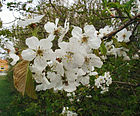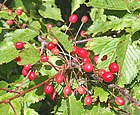Note: This is a project under development. The articles on this wiki are just being initiated and broadly incomplete. You can Help creating new pages.
Prunus avium - Elavālukaṃ
Elavālukaṃ consists of dried mature seed of Prunus avium Linn.f. (Fam. Rosaceae), a tree cultivated in Kashmir and lower Himalayas of Uttar Pradesh and W. Bengal seeds available in the market are enclosed in hard woody endocarp.
Contents
[hide]- 1 Uses
- 2 Parts Used
- 3 Chemical Composition
- 4 Common names
- 5 Properties
- 6 Habit
- 7 Identification
- 8 List of Ayurvedic medicine in which the herb is used
- 9 Where to get the saplings
- 10 Mode of Propagation
- 11 How to plant/cultivate
- 12 Commonly seen growing in areas
- 13 Photo Gallery
- 14 References
- 15 External Links
Uses
Cystitis, Oedema, Bronchial complaints, Anaemia, Cough, Indigestion, Respiratory problems, Looseness of the bowels.
Parts Used
Chemical Composition
It contains Prunasin (D-mandelonitrile-β-glucoside), Quercetin-3-0- rutinosyl-7, 3-0-biglucoside, Kaempferol-3-0-rutinosyl-4'-di-0-glucosideand 6-ethoxykaempferol.[1]
Common names
| Language | Common name |
|---|---|
| Kannada | |
| Hindi | Aaluvaalu, Gilaas, Krusabala |
| Malayalam | |
| Tamil | |
| Telugu | Jeevakamu |
| Marathi | NA |
| Gujarathi | NA |
| Punjabi | NA |
| Kashmiri | NA |
| Sanskrit | Aileyaḥ, Elavālūḥ, Elukākhyaḥ |
| English | Sweet Cherry |
Properties
Reference: Dravya - Substance, Rasa - Taste, Guna - Qualities, Veerya - Potency, Vipaka - Post-digesion effect, Karma - Pharmacological activity, Prabhava - Therepeutics.
Dravya
Rasa
Kaṣāya
Guna
Rūkṣa, Laghu
Veerya
Śīta
Vipaka
Kaṭu
Karma
Kaphahara, Yonidoṣahara, Varṇya, Stambhana, śukraśodhaka, Vedanāsthāpana, Viḍaghna
Prabhava
Habit
Identification
Leaf
| Kind | Shape | Feature |
|---|---|---|
| Oval | Oblong | Green and toothed with pointed tips, measuring 6–15cm with two red glands on the stalk at the leaf base. They fade to orange and deep crimson in autumn |
Flower
| Type | Size | Color and composition | Stamen | More information |
|---|---|---|---|---|
| Hermaphrodite | 8-15mm across | White | Meaning the male and female reproductive parts are found in the same flower, in April |
Fruit
| Type | Size | Mass | Appearance | Seeds | More information |
|---|---|---|---|---|---|
| Oblong pod | Thinly septate, pilose, wrinkled | After pollination by insects, the flowers develop into globular, hairless deep red cherries | Seeds upto 5 | Fruiting throughout the year |
Other features
List of Ayurvedic medicine in which the herb is used
Where to get the saplings
Mode of Propagation
How to plant/cultivate
Seed - requires 2 - 3 months cold stratification and is best sown in a cold frame as soon as it is ripe[200]. Sow stored seed in a cold frame as early in the year as possible[200]. Protect the seed from mice etc. The seed can be rather slow, sometimes taking 18 months to germinate [3]
Commonly seen growing in areas
Photo Gallery
References
- Jump up ↑ The Ayuredic Pharmacopoeia of India Part-1, Volume-5, Page no-57
- Jump up ↑ Morphology
- Jump up ↑ Cultivation details
External Links
- Ayurvedic Herbs known to be helpful to treat Cystitis
- Ayurvedic Herbs known to be helpful to treat Oedema
- Ayurvedic Herbs known to be helpful to treat Bronchial complaints
- Ayurvedic Herbs known to be helpful to treat Anaemia
- Ayurvedic Herbs known to be helpful to treat Cough
- Ayurvedic Herbs known to be helpful to treat Indigestion
- Ayurvedic Herbs known to be helpful to treat Respiratory problems
- Ayurvedic Herbs known to be helpful to treat Looseness of the bowels
- Herbs with Fruits used in medicine
- Herbs with common name in Hindi
- Herbs with common name in Telugu
- Herbs with common name in Sanskrit
- Herbs with common name in English
- Habit - Herb
- Index of Plants which can be propagated by Seeds
- Index of Plants which can be propagated by Cuttings
- Herbs that are commonly seen in the region of Temperate area
- Herbs
- Ayurvedic herbs that don't have seed photos
- Rosaceae





